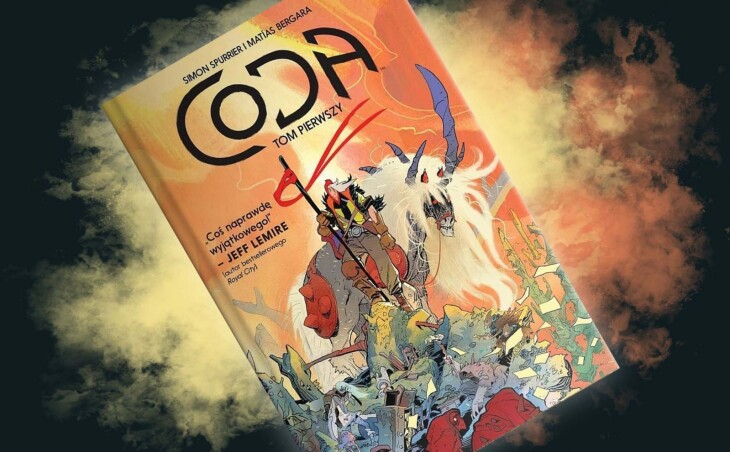Typically, fantasy stories describe worlds that stand on the brink of extinction. Some ancient evil tries to destroy all existence, but at the last moment it is stopped by the hero (ka) or their entire team. What if the disaster had not been stopped? Coda Simon Spurrier and Matias Bergar, published by Non Stop Comics, answers this question.
“Coda” is an Italian word originally used to describe the ending of a piece of music. Over time, other epilogues came to be called with this name. So does Spurrier in his comic book crown any other work? No, the source of the title is different. Well, the screenwriter took a typical post-Tolkien world and … brought the apocalypse upon it. This is by no means a revolutionary idea, so I am surprised that it appears so rarely.
Uwertura
So, not long ago, the Lords of Being harnessed hordes of urks (as the orcs are called here) to conquer the world. The allied forces ultimately (say) won, though it came at an enormous cost. Mighty ilves (elves) are close to extinction, and with them almost all the magic of this world has been exhausted. In these realities we meet the bard Hum. It would seem that he was a cynic with no regard for anyone but himself. He treats all the people he meets as an object, he establishes contact with them only if it brings him closer to achieving his goal. And that is gaining the remnants of magic to lift the curse off his wife.
Strong
Cody’s worldit is full of nasty people (and equally horrible representatives of other races). Hum himself has a lot behind his ears, but he is surrounded by opportunists, two-faced people and such distorted individuals. Like Sapkowski’s, if someone shows even noble motives, he will either face punishment or turn out to be a complete idiot. This comparison is not accidental, because the bard, like a certain white-haired witcher, has a tendency to accidentally be in the wrong place at an even worse time. Every now and then he gets entangled in intrigues that do not directly concern him, but still complicate his life. The comic is also full of black humor. My favorite character, the “Pentecorn”, is a total distortion of the dignity and nobility of unicorns. Hum’s mount is perpetually frothy and the blasphemies that fall from his mouth are so terrible that they cannot even be put into words. Hence, in the balloons we see pictograms with skulls – a theme known, for example, from curses in Disney titles.
Booklet
There are more narrative games. I’ve never been a fan of comics with character speech bubbles. For the reason that they often don’t make sense in the world presented. In my review, Batman who laughsI remind screenwriter Scott Snyder for sticking in Gack’s mouth texts that are spoken to an undefined addressee. Often there is also the problem of redundancy – the text and the picture show the same thing. For what? It works much better with Spurrier. Hum writes romantic letters to an enchanted wife who cannot accompany him on his journey. The problem is that what is dressed in beautiful words often has nothing to do with brutal reality. The remnants of intelligent races, despite the enormity of the catastrophe, continue to fight brutally with each other, and the bard himself is not an angel. In this way, the written word and the drawings contrast with each other in a very ingenious way.
Staff
It also happened that a good script was completely laid down by poor drawings. However, this is not the case. Matias Berger did a great job. His characters are properly styled (there is no cliché), and their faces have a wide range of expression. A lot (a lot) can happen in the frame and very brutal at times. Sometimes the perspective is disturbed, although he does not treat it as a disadvantage – it only enhances the expressiveness of the drawings.
Everything has been beautifully colored by Michael Doig. Most of the pages are bathed in yellow, perfectly illustrating the post-apo atmosphere. Where there is magic, more psychedelic colors come into play.
In the add-ons you can find a standard cover gallery, among them another gem from Jakub Rebelka. Two maps, so typical of the fantasy genre, are also a great complement. One shows the world “before” and is carefully made, as if it came from the hands of a cartographer. The second one shows the land “after” – sketched quickly and full of notes (eg “I think some big spiders!”, Probably drawn by Hum. Spurrier is very good at world-creating.
Codetta
I read a few fantasy comics lately and even if I liked it, there was always a “but”. Released by Egmont Conan The Barbarian from Marvel, it is a nice story, but very classic. The Land of Ruins from Non-Stop is a sweet and charming story, although here too there was no idea for a more interesting story. Head Lopper is a phenomenal title , although here, too , dynamics and visual narrative are more important than the story content. I used to be delighted with Ralph Azham, although the cynical story is devoid of epic setting, and the second story arc did not have that power anymore. And finally this one title came out that bought me the whole thing. And his name is Coda .

